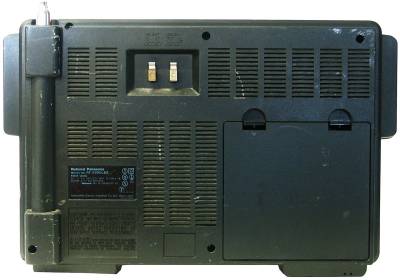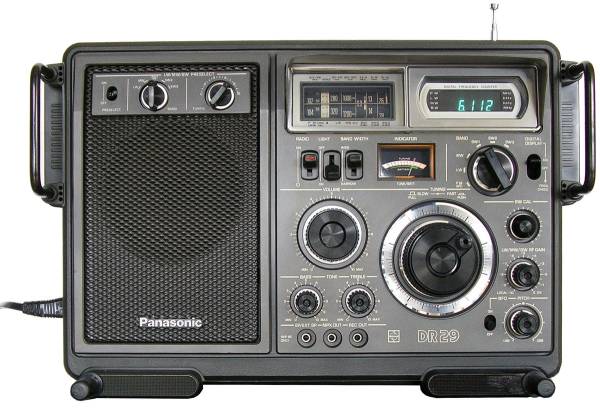Inhaltsverzeichnis
National Panasonic DR-29 / RF-2900LBS
Manufactured by National Panasonic, Osaka.
The RF-2900LBS / DR-29 is a set very similar to the DR-28 receiver, a preselector was added, resulting in a significantly improved performance in large-signal surroundings.
Variants
- DR-29 / RF-2900 LBS: blue fluorescent display, preselector, long wave, FM 87.5 - 108 MHz
- RF-2900: Caution: not identical, US - model with blue fluorescent display but without preselector!
Technical data
- Frequency range: FM, LW, MW, 6 x SW (1.6 - 26.1 MHz)
- Frequency display: digital display, 1 kHz
- Frequency memory: none
- Sensitivity: MW 32 μV, SW AM (A3) 1.8 - 2.4 μV, SSB 1.1 - 1.4 μV; Selectivity:3.8/13.1 kHz, 8.1/27.3 kHz (-6/-60 dB)
Power supply
- Mains operation: 110, 220 V
Dimensions
- 380 x 250 x 120 mm, weight 3.6 kg
Accessories
Operation
Like its „twin brother“, the DR-29 measures 38 x 25 x 12 cm and has a weight of 3.6 kg. Two handles or protective bars on the sides protect the front of the unit if the receiver has to be pushed under the seat of an aeroplane on the way to the holidays… The DR-29 can alternatively be operated from 110/220 V mains power or with 6 UM-1 batteries.
The left part of the front panel is dominated by the large loudspeaker grill, the sound is above average with 2.3 W sine power. In contrast to the DR-28, the controls of the switchable preselector are located at the top of the speaker grill.
At the top, side by side, are the two windows for the analogue coarse dial with markings for the most important broadcast bands and next to it for the five-digit blue-green fluorescent display, which indicates the reception frequency with an accuracy of 1 kHz.
In the next row, the mains switch, the switch for the dial illumination (can be turned off to save battery power) and the bandwidth switch for the narrow and wide IF filter are located next to each other. The analogue S-meter tends to read high. At the right, the operation mode switch and the switch to turn off the frequency display (also to save power and to avoid interference caused by the meter's electronics).
In the middle is the large and easy-to-grip main tuning knob, for fine tuning the whole knob can be pulled out, activating a backlash-free 1:20 reduction. To the left of this, the large volume control and separate controls for bass and treble are located. To the right of the tuning knob, three controls are arranged one above another. With SW-CAL, the calibration of the frequency counter can be shifted up to 5 kHz and can be calibrated by means of a signal generator or a transmitter on a known frequency. With the RF gain, the RF amplification can be reduced if strong transmitters lead to overload; the BFO control is used for CW and SSB reception.
 The signal coming from the antenna is amplified in an RF amplifier stage and is fed to the first mixer. After being converted to the second IF and having passed the IF filters, the signal reaches the AM detector stage, here the subcarrier generated in the BFO is mixed for SSB/CW reception. After the tone control, the audio signal from the final amplifier is fed to the loudspeaker. The oscillator frequency is decoupled in the first mixing stage and fed to the frequency counter module.
The signal coming from the antenna is amplified in an RF amplifier stage and is fed to the first mixer. After being converted to the second IF and having passed the IF filters, the signal reaches the AM detector stage, here the subcarrier generated in the BFO is mixed for SSB/CW reception. After the tone control, the audio signal from the final amplifier is fed to the loudspeaker. The oscillator frequency is decoupled in the first mixing stage and fed to the frequency counter module.
In practical use, the DR-29 is a reliable world band receiver which can be used for DXing and which has a pleasant audio. With the preselector switched on, an additional circuit has to be tuned, but the large-signal behaviour is so much improved, so that so that overloading and „mirror stations“ occur much less ften than with the DR-28.
Thanks to the switchable preselector in the RF-2900 model, the danger of overload is somewhat reduced with this receiver, but even the DR-29 with its preselector cannot cope with really long long-wire antennas; it should not be expected to handle more than 5 - 7 metres of wire so the RF gain control has to be reduced to reduce RF signal level to an S-meter reading of around 8 - 9.
The sensitivity is quite good, the selectivity in crowded bands is only acceptable when the narrow IF filter is in use. The wide IF filter with its very wide skirts should only be used on frequencies with free 5 kHz adjacent channels. The receiver has a tendency to drift slowly after switching on as well as during operation. As the frequency can shift by up to 4 kHz in one hour and even when touching the rod antenna, single sideband reception is difficult. ECSS reception, where AM signals are mixed with the BFO carrier and the SSB demodulator is used, is not possible with the DR-29. The frequency on the display may differ slightly from the actual operation frequency, so after a frequency announcement, the signal must be adjusted to maximum with the SW-CAL control. Performance in the FM broadcast band with the high resolution of the frequency display is quite good im comparison to other Japanese sets.
In summary, the DR-28 and especially the DR-29 equipped with the additional preselector is a well performing world band receiver for the beginner who wants to do simple DX and also listen to SSB signals in amateur bands and who can do without all the achievements of digital technology such as memory and clock functions. Compared to small travel radios, the selectivity and sensitivity as well as the audio from the large loudspeaker are considerably better, so that a DR-29 purchased at a reasonable price can be a temptation that one can loose not his head but his ears to the fascination of signals coming from different corners of the world.
In Europe, make sure you get the DR-29 or RF-2900LBS as the American RF-2900 is more similar to the European DR-28 and comes without preselector.
Technical principle
Double conversion superhet, digital frequency counter.
Components
The set is equipped with semiconductors.




